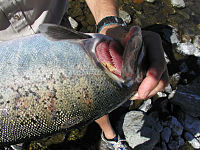Enfermedad de la Columna
| Flavobacterium columnare | |
|---|---|
| Kingdom | Bacteria |
| Phylum | Bacteroidetes |
| Class | Flavobacteria |
| Order | Flavobacteriales |
| Family | Flavobacteriaceae |
| Genus | Flavobacterium |
| Species | F. columnare |
Causado por: Flavobacterium columnare
Conocido previamente como: Bacillus columnaris — Chondrococcus columnaris — Cytophaga columnaris — Flexibacter columnaris
Introdución
F. columnare es una bacteria gram-negativa, aeróbica, con forma de barra responsable por la Enfermedad de la Columna en peces.[1]
Este enfermedad no es zoonótica.
Distribución
Mundial. El organismo es ubicuo en ambientes acuáticos de agua dulce.
Peces Susceptibles
Una amplia gama de peces huéspedes pueden ser infectados, incluyendo la trucha y la familia de los salmones, anguilas, la carpa dorada, peces siameses de lucha, el bagre y las especies de percha. Peces cultivados, los peces en libertad y los peces de acuario pueden ser afectados a pesar de los peces cultivados criados en estanques o canales son la principal preocupación. No se reconoce como un problema en las poblaciones de peces silvestres.
La enfermedad de la columna puede ocurrir en los peces de agua fría y caliente, pero es más frecuente en las temperaturas del aire por encima de los 12 a los 14⁰C.
Abrasiones en la piel, los factores de estrés y agua caliente todos aumentan el riesgo y la prevalencia de la infección.
Signos Clínicos
The skin and fins of infected fish may darken or lighten in colour and circular yellow-grey opalescent necrotic patches or erosions are visible on the skin and/or gills. The gill filaments may have whitish spots on their tips. Mucus often also accumulates on the gills, head and dorsal regions. In advanced disease, erythematous spots are widespread. Inappetance and lethargy are common, as are mortalities. Gill lesions cause respiratory distress and its associated clinical signs – gulping air, sinking, erratic behaviour etc. Morbidity can approach 100% and mortalities are highest in younger fish.
In catfish specifically, severe tissue necrosis develops into “saddleback” lesions on the dorsum.
Diagnóstico
Bacteria can be isolated from gills, skin and sometimes internal organs, particularly the kidneys.
The pathogen can then be cultured on reduced nutrient agar, such as cytophaga agar. Culture is often more successful by inhibiting contaminant growth on the agar by adding neomycin or polymyxin B. The bacterium will also grow at 37⁰C which will inhibit most other pathogens of interest so can be used as an inhibitory factor. Colonies are small, 3-4mm in diameter and grow within 24h. They are characteristically and uniquely rhizoid in structure and pale yellow in colour, and adhere to the agar surface. They stain pink when exposed to potassium hydroxide. This pathognomic culture finding can be used as a definitive diagnosis for columnaris disease, especially where clinical signs are present.
Phenotypic tests can then be carried out on colonies if in any doubt.
Microscopy of wet tissue mounts from gill or skin scrapings often reveals haystacks or columns of bacteria. Cells can also form chains, giving the impression of a longer, single prokaryotic cell.
Tratamiento
Potassium permanganate, copper sulphate and hydrogen peroxide can be applied externally to adult fish and fry but can be toxic at high concentrations.
Terramycin can also be added to feed for adults, fry or broodstock, but resistance is emerging.
Vacunas can also be given in the face of an outbreak.
Control
Existe una vacuna contra la F. columnare, que consiste en de células enteras matadas en formol.
Referencias
- ↑ Bernardet, J. F., Segers, P., Vancanneyt, M., Berthe, F., Kersters, K., Vandamme, P (1996) Cutting a gordian knot: emended classification and description of the genus Flavobacterium, emended description of the family Flavobacteriaceae, and proposal of Flavobacterium hydatis nom. nov. (basonym, Cytophaga aquatilis Strohl and Tait 1978). International Journal of Systematic Bacteriology, 46:128-148
Starliper, C.E. and Schill, W.B. 2011. Flavobacterial Diseases: Coldwater Disease, Columnaris Disease, and Bacterial Gill Diseases. In: Fish Diseases and Disorders Volume 3: Viral, Bacterial and Fungal Infections, 2nd. Edition (eds. P.T.K. Woo and D.W. Bruno), CABI, Wallingford, UK, pp. 606-631

|
Este artículo fue originalmente de The Animal Health & Production Compendium (AHPC) publicado en el web por CABI. Hoja(s) de datos utilizados: columnaris disease and Flavobacterium columnare el 11 July 2011 |
| Este artículo ha sido revisado por el experto Prof Patrick Woo MSc PhD Fecha de revisión: 24 de Agosto del 2011 |
